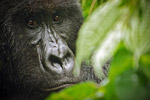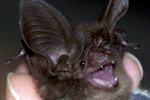Development of roads and other structures disturb large, continuous patches of habitat for wildlife. This habitat fragmentation is one of the biggest contributors to species extinction, as the local ecology and species interactions are altered. A new study published in mongabay.com’s open-access journal Tropical Conservation Science finds that leaf-nosed bat abundances in Mexico are closely linked to how sensitive each species is to habitat fragmentation.
Found in Central and South America, New World leaf-nosed bats are the most diverse family of bats. Characteristic of their appearance is the leaf-like structure on their nose, which is thought to be used for echolocation. In the tropics, they fulfill key ecological roles as seed dispersers, pollinators, and arthropod predators.
 Heller’s broad-nosed bat (Platyrrhinus helleri) was one of the bats in the study. Photo by: Garcia-Garcia et |
Researchers captured and identified bats in areas both with continuous forest and fragmented forest in Los Chimalapas tropical rain forest in Oaxaca, Mexico. Here, vegetation cover has undergone decline since the 1950s due to disturbance from forest fires, semi-intensive livestock, and extraction of timber trees.
Examining several ecological traits that could be associated with sensitivity to fragmentation, the scientists found that species that are less abundant are also at greater risk of decline from fragmentation.
“Species such as Toltec fruit-eating bat, Gray’s long-tongued bat, Salvin’s big-eyed bat, Gray short-tailed Bat, and highland yellow-shouldered bat are highly sensitive to habitat fragmentation,” the study reports. “These species are locally less abundant in their distribution range in Mexico and exhibit small population sizes.” Moreover, these species are less able to move over large distances. Thus, fragmented landscape limits their movement even further.
On the other hand, some other species – particularly those that are resilient to habitat disturbance and those that prefer foraging outside pristine forest – are not only less affected, but could possibly do better in a fragmented landscape. These species are also able to travel longer distances.
“This finding is relevant because natural abundance and population size are fundamental to determining the degree of sensitivity to fragmentation and local extinction risk of a species,” the authors write. “The adequate identification of these traits, not only in bats but also in other groups such as non-flying mammals, birds, reptiles, and amphibians could be essential for effective species-specific conservation strategies.”
Citations:
- García-García, J.L., Santos-Moreno, A., Kraker-Castañeda, C. (2014). Ecological traits of phyllostomid bats associated with sensitivity to tropical forest fragmentation in Los Chimalapas, Mexico. Tropical Conservation Science, 7 (3): 457-474.
Related articles
Don’t eat or touch bat bushmeat amid worsening Ebola outbreak, UN warns
(07/29/2014) The world’s worst Ebola outbreak was likely begun by a hunter shooting a fruit bat for their dinner or the market, according to the UN. The outbreak has killed over 660 people in six months to date, and recently spread via plane to Nigeria. The disease is particularly deadly with a mortality rate of around 90 percent.
What’s an environmental journalist to do with so much good news?

(06/12/2014) As an environmental journalist covering stories from the great Arctic ice melt to the rhino poaching crisis in Africa, you’ll forgive me if sometimes in the morning—before I turn my computer on—I have a sudden desire to spend a few extra minutes in bed or have a leisurely breakfast with my daughter or just sit in the back yard with a cup of tea and a good book.
PhD students ‘thrilled’ to rediscover mammal missing for 124 years

(06/11/2014) In 1890 Lamberto Loria collected 45 specimens—all female—of a small bat from the wilds of Papua New Guinea. Nearly 25 years later, in 1914, the species was finally described and named by British zoologist Oldfield Thomas, who dubbed it the New Guinea big-eared bat (Pharotis imogene) after its massive ears. But no one ever saw the bat again.